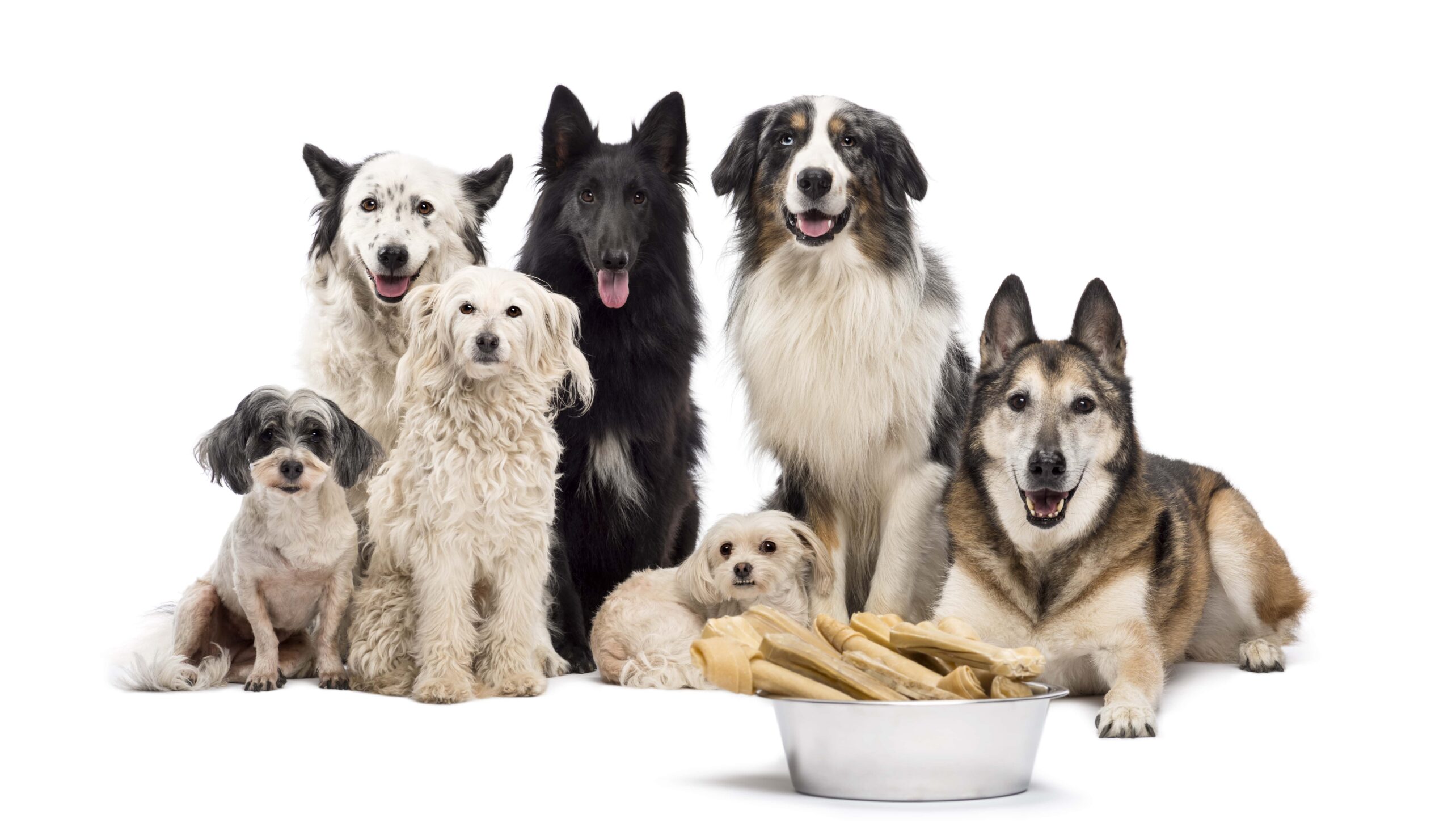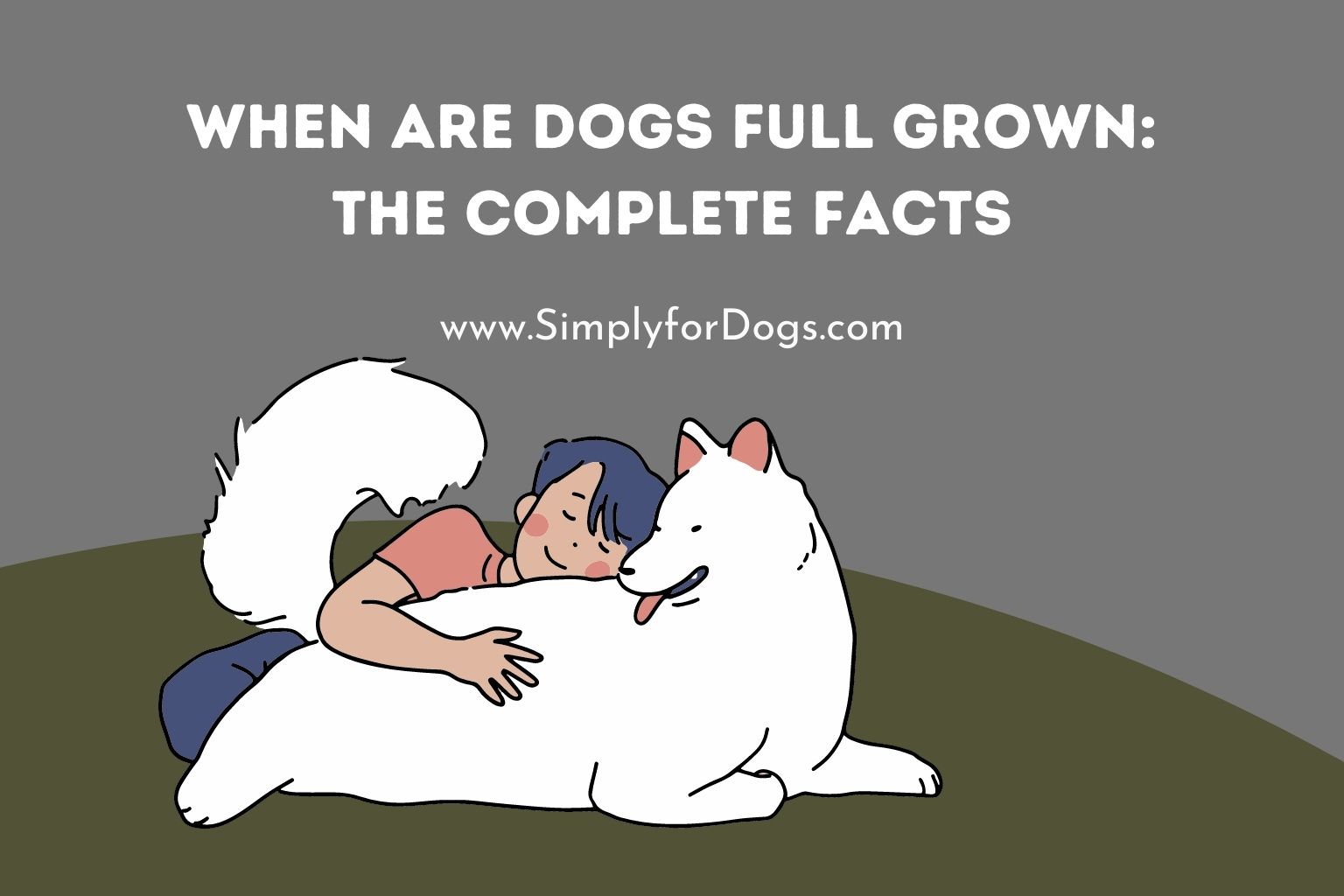If you’re of a certain age, you might remember a Purina commercial that featured an animated puppy and exhorted you to feed “Puppy Chow for a full year, till he’s full grown.” If you don’t remember it, take a look here – it’s pretty cute! But was the dog food manufacturer right? When are dogs full grown? Is it a year? Keep reading to learn more!
When do Puppies Stop Growing?
I suppose that I could be flippant here and say that puppies stop growing when they’re done growing. However, that wouldn’t give you the information you need to determine what to feed your puppy to ensure that he achieves his proper size.It wouldn’t provide you with any useful information at all. You need to know more, and we’ll get to that in the sections on specific breeds and breed sizes.
Was Purina right? Is your puppy full grown at one year?
Puppies are not necessarily full gown within a year. You may have heard that a dog is fully mature at one year but it’s important to know the difference between growth and maturity. When your veterinarian tells you that your puppy is “fully mature” when he reaches the age of one year, what he or she means is not that your puppy has finished growing, but that your puppy can reproduce. He or she is sexually mature, able to father or conceive a litter, but not necessarily physically mature. So when are dogs full grown?
Before we get into specific types of dogs, we can offer some generalizations. Most dogs are fully grown at a year to a year and a half, but some take longer. It depends on the breed of dog. Small breeds, like Shih Tzus, Toy Poodles, and Yorkshire Terriers usually do achieve their full growth at one year, or even less. Medium to large size dogs, like Labrador Retrievers, German Shepherds, and Rottweilers achieve their full growth at a year and a half to two years. Giant breeds like Great Danes and English Mastiffs may not attain their full size until they’re three years old.
With purebred dogs, you usually have a good idea of what you’re going to get. A way to estimate their size is to use an online puppy size calculator. Keep in mind that these will only give you an approximate guess and not a 100% accurate size and weight.
Sound complicated? Well, it is in a way, since there’s also a fair bit of variation among breeds and breed mixes. You can have a small breed of dog that’s at the lower end of the size scale for his breed, a large breed that’s at the high end, and anything in between. Mixed breeds can be all over the map. Just as an example, if you cross a Beagle (15-30 pounds) with a Golden Retriever (65-75 pounds), you could end up with a dog that will probably be somewhere in the mid-range, but could still be as small as 15 pounds or as big as 75 pounds. That’s quite a range!
Perhaps what you’re wondering about is not so much when your puppy will mature into a full-sized adult dog. You might be more interested in knowing when your little friend is going to stop acting like a puppy! In other words, you’re not wondering when your puppy will stop growing – you’re wondering when he’ll grow up!
Again, there can be a lot of variation when it comes to different breeds. Some dogs will settle down at about a year, while others take a lot longer. Again, it seems as though the smaller the breed, the quicker they exit what in human terms would be the “terrible twos” and start acting like adults. Toy Poodles and Shih Tzus, for instance, will typically settle down and become a bit more sedate when they’re about a year old. Herding dogs, like Collies and Welsh Corgis, may take a couple of years. Giant Breeds like English Mastiffs can take up to three years (their physical maturity and their emotional maturity seem to go hand-in-hand). Some dogs (Labrador Retrievers and Rottweilers most notably) often remain puppies in their minds for as long as they live!
Usually, there’s a big difference between the behavior of a puppy and that of an adult dog. Puppies will run toward you and jump on you, nip at your heels and just generally make nuisances of themselves – cute little nuisances! Adult dogs, if not properly trained, might do the same but without quite so much enthusiasm. In adult dogs, destructive behavior like chewing your shoes or getting into garbage will usually subside a bit. In other words, adult dogs are a bit more restrained than puppies. If your puppy becomes less destructive and exuberant, chances are that he’s growing up emotionally.
So when are dogs full grown? Did Purina get it right?
Not really. They just had a really cute ad campaign going on. Sexual maturity, physical maturity, and emotional maturity are very different things and how long it takes can vary a great deal among different breeds. With that in mind, let’s talk about different breeds, different sizes, and what they need to become strong, healthy adult dogs.Dogs Full GrownNot really. They just had a really cute ad campaign going on. Sexual maturity, physical maturity, and emotional maturity are very different things and how long it takes can vary a great deal among different breeds. With that in mind, let’s talk about different breeds, different sizes, and what they need to become strong, healthy adult dogs.
Small-medium dog breeds
These pups tend to reach their full-sized framework between six and eight months old, and they’ll typically fill out to their full weight by 12 months old.
Popular Small Breeds
Among the most popular small breeds are Chihuahuas, Miniature Dachshunds, Pugs, Jack Russell Terriers, Boston Terriers, Shih Tzus, and Toy Poodles.
Grow Time
These little guys are typically considered to be fully mature at a year.
Size Growth
They might reach their full height at as little as six months, but continue to put on weight. These dogs could weigh as little as 6 pounds (I’m not including teacup dogs here) and will never reach more than 30 pounds.
Type of Food
Choose quality dog food specifically formulated for small breeds.
Related Content:
How Big Will My Puppy Be When He’s Full Grown?
Top 9 Mistakes New Dog Owners Make
Can Dogs and Babies Grow Up Together Safely?
Medium-large dog breeds
These dogs usually achieve their full growth at about a year and a half.
Popular Medium-large Breeds
Popular breeds include the American Staffordshire Terrier, Standard Poodle, Airedale Terrier, Labrador Retriever, and Golden Retriever.
Grow Time
These dogs will achieve their full height at about a year but will continue to “bulk out” until they’re a year and a half old.
Type of Food
Oddly enough, most medium-to-large dog breeds tend to be pretty active, so it’s best to offer dog food formulated for high-energy dogs. If in doubt, ask your veterinarian for food recommendations.
Giant dog breeds
Giant breeds can take a long time to achieve their full growth.
Popular Giant Dog Breeds
The giant breeds include English Mastiffs, Bull Mastiffs, Newfoundlands, Saint Bernards, and Great Pyrenees.
Grow Time
Very large dogs will typically reach their full height by the time they’re a year and a half old but will take up to three years to attain their full weight and bulk.
Size Growth
A giant breed can grow to be more than 200 pounds. The biggest dog ever recorded was an English Mastiff named Zorba, who weighed an incredible 315 pounds!
Type of Food
Giant breeds should be fed dog food that is specifically formulated for very large dogs.

Common Questions
Can you tell how big a puppy will get?
If your puppy is purebred, you can probably hazard a pretty good guess. For example, a Beagle will usually weigh about 15 pounds, and never more than 30. A Rottweiler will seldom weigh less than 85 pounds, and never more than 140. If you’re dealing with a hybrid or a mutt, though, you may not be able to know what you’re getting until your dog is fully mature.
How can I estimate my dog’s size?
Usually, by the time a puppy reaches the age of four months, he will have attained about 60% of the size he will be as an adult. My mom didn’t raise a mathematician but it’s easy if you just assume that for every 10 pounds your dog weighs at four months, he’ll add four when he’s reached his full growth.
Does paw size determine dog size?
Sometimes you can get a good idea of the size of the dog from the size of his paws. You can often assume that if a puppy has really big paws, it means that he’s going to need them to support his adult weight. However, sometimes puppies “grow into” their paws, and the paw size during puppyhood ends up not meaning much.
How do you pick a puppy from a litter?
Do it with your brain, not with your heart. It’s easy to want to take home the little guy who looks like he’s so lost and alone, but it’s generally a bad idea. Instead, choose the well-adjusted puppy who wants to meet humans, play with his littermates, and snuggle up with his mother. Also, avoid the puppy who’s bullying his littermates – there’s a good chance he’ll give you attitude problems later on.
Is the biggest puppy in the litter the biggest dog?
Not necessarily! What a lot of people don’t realize is that a bitch can be in heat for weeks, and can conceive at any time she’s willing to stand for a male. Usually, she’ll be willing to stand for several days. Puppies can be conceived days apart and if the bitch is exposed to more than one male, they could even have different fathers. The puppy that’s born first is usually the last one fertilized and will, therefore, be the smallest since the other puppies have been in the womb for much longer. The last one fertilized will catch up eventually, and could even end up being the biggest dog out of the litter!
Is a 60-pound dog big?
Try handling an untrained 60-pound dog and then tell me how big you think it is! A 60-pound dog would be considered medium to large.
How do you train a stubborn dog?
You train a stubborn dog the same way you train any other dog – with lots of patience and positive reinforcement and never with harsh treatment. Use praise and treats, not a heavy hand. It’s easy to become frustrated when your dog is being stubborn but please resist the temptation to shout – it hurts your dog’s feelings and does nothing to further the learning process. It should also go without saying that you should never, under any circumstances, strike your dog.
Are puppies full grown at 6 months?
Some very small breeds might be considered to be fully grown physically at six months. Emotionally, though, they’ll remain puppies for a bit longer.
Conclusion
So, when are dogs full grown? Depending on the breed, dogs can be physically grown at as little as six months, or it can take as long as three years. Small breeds achieve full growth quickly and giant breeds can take a long time. It’s important to feed your dog a diet that is appropriate for his size and activity level.
If your dog appears not to be growing quickly enough for his particular breed, consult your veterinarian to identify any health issues that could be inhibiting growth. A change in diet may also be needed.
One thing you don’t need to worry about is when your puppy going to grow up emotionally. Some breeds take a bit longer to mature than others and some never fully outgrow puppy personality no matter how big they get, although the heel nipping and destructiveness will generally level off.
Related Content:
How Big Will My Puppy Be When He’s Full Grown?
Top 9 Mistakes New Dog Owners Make
Can Dogs and Babies Grow Up Together Safely?
Sources:
“https://www.youtube.com/watch?v=ljpUTcN6U8Q“

